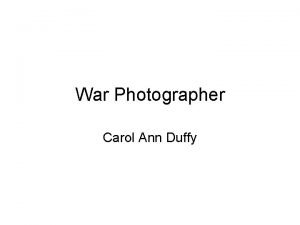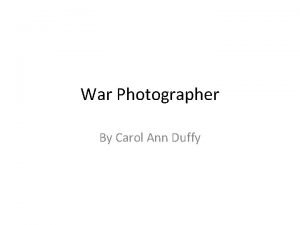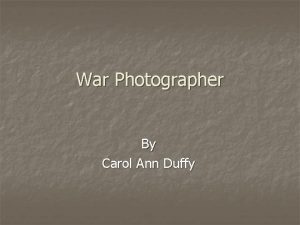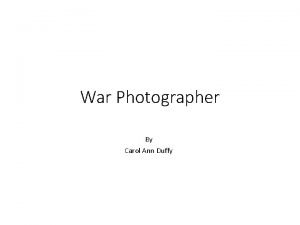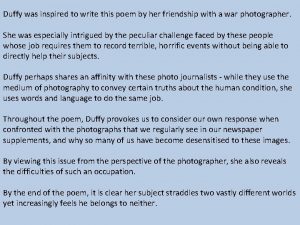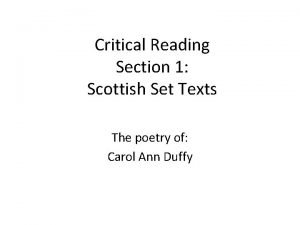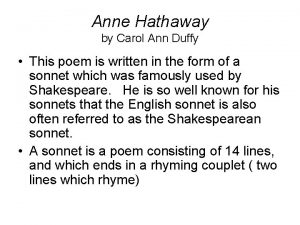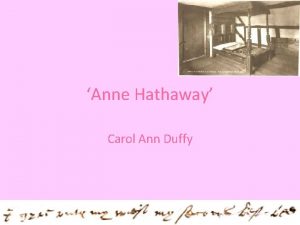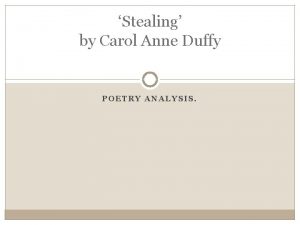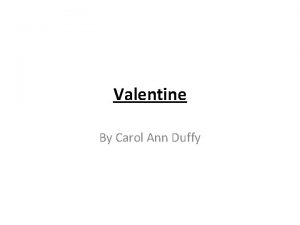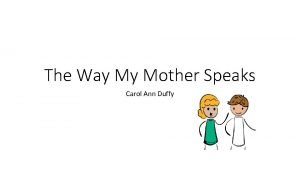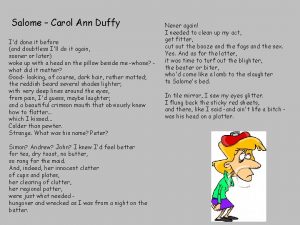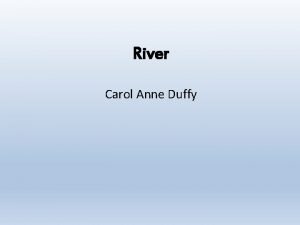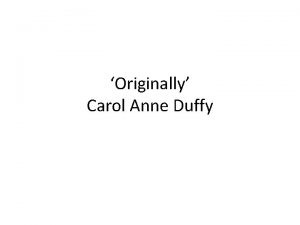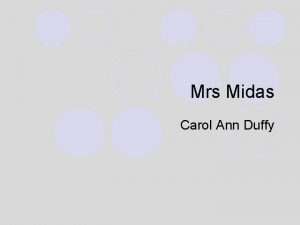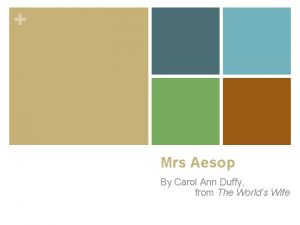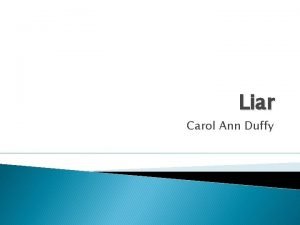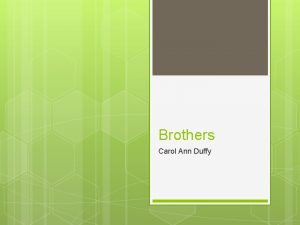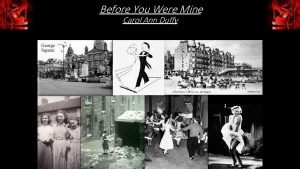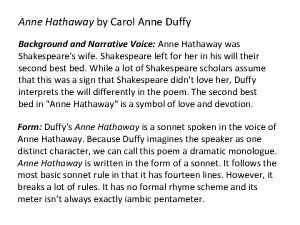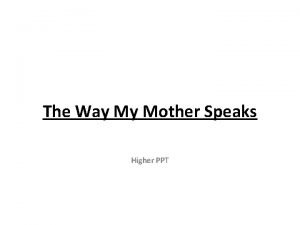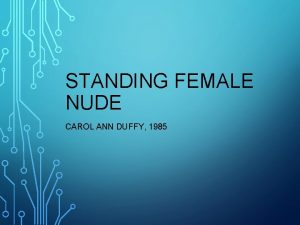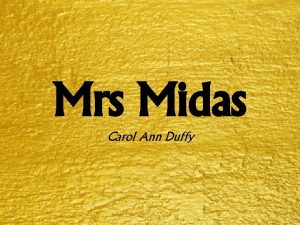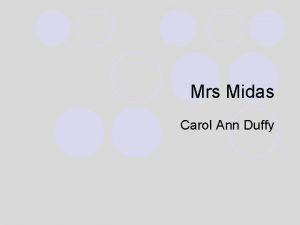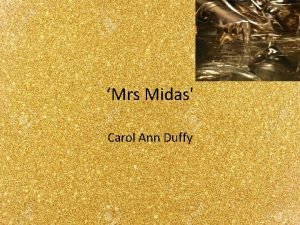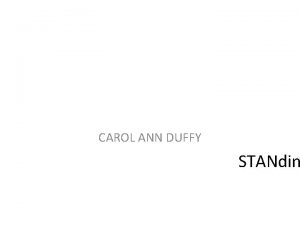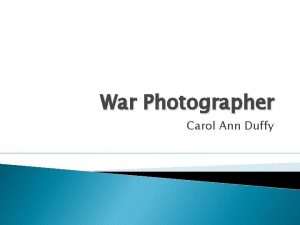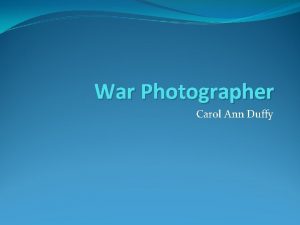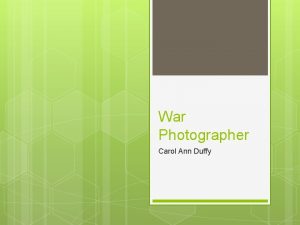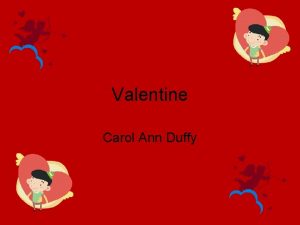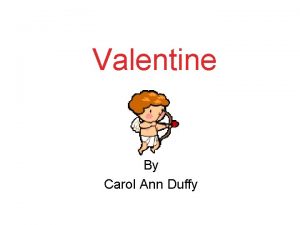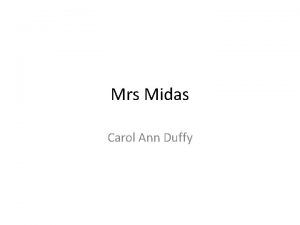War Photographer Carol Ann Duffy Summary War Photographer








































- Slides: 40

War Photographer Carol Ann Duffy

Summary • War Photographer taken from poetry collection, ‘Standing Female Nude’ in 1985. • Her motivation for writing this poem came from her friendship with two well-known war photographers: Don Mccullin and Phillip Jones Griffiths. • The photographer in our poem is anonymous. Duffy has deliberately done this to show he fits into neither world; peaceful one or war torn one.

Summary • Duffy uses this poem to show differences between: • 1. ‘Rural England’- a place which is peaceful and compares this with countries which are torn apart by battles. • 2. Indifference of newspaper editor and readers and compares this with the suffering of the people in the photos.

General points 1. Duffy describes the experience of someone whose job it is to witness terrible atrocities. 2. Duffy has written this poem to show the war photographer deals with traumatic experiences and atrocities.

Stanza 1 • ‘darkroom’ • word choice • Literally a room where a photographer develops their photos. • However, ‘dark’ has connotations of a serious, brooding, grim, evil place. • ‘dark’ applies to the photographer’s mind and suggests that he has been taken to a dark place, emotionally and mentally; he is anxious, scared, and distressed by what he sees. • He cannot escape.

Stanza 1 • ‘finally alone’ • Inversion and word choice. • Inversion is when the author moves the words from one part of the line to another part; here, Duffy moves the words from the start of the line to the end. • The effect of doing this is to create emphasis. • The emphasis on these words reflects the loneliness of his job, separated from his subject, reader and editors.

Stanza 1 • ‘finally alone’ • Word choice • Creates this idea that our war photographer has been longing to be alone for a long time; he is desperate to escape something or someone.

Stanza 1 • ‘spools of suffering’ • Alliteration is the repetition of an initial consonant sound. • Here it is the consonant, ‘s’ which is repeated in the words ‘spools’ and ‘suffering. ’

Stanza 1 • ‘spools of suffering. ’ • Alliteration is effective as it reflects the repetition of the spools laid out on the table. • Mirrors the repetitive arrangement of the canisters of film. • It shows how many photos there are which, in turn, shows the amount of suffering the photographer has captured.

Stanza 1 • ‘ordered rows’ • It brings to mind rows of tombstones, or ranks of soldiers which links back to the horrors of war which the war photographer has captured on film.

Stanza 1 • ‘only light is red and softly glows’ • Symbolism, word choice and contrast. • ‘only’ is effective word choice as it builds on the idea of solitude and loneliness. • ‘red’ turns a very ordinary process into something dangerous. It symbolises danger or blood; things which are reflected in the war photographer’s pictures. • ‘softly glows’ offers a contrast as it creates a very gentle atmosphere which is incomplete opposition to the atmosphere he photographs.

Stanza 1 • ‘as though this were a church and he a priest preparing to intone a mass. ’ • Extended image which is extended further in the last line of this stanza by the biblical reference. • All throughout this stanza, Duffy is comparing ideas: • 1. The ‘darkroom’ is compared to a church. • 2. The war photographer is compared to a priest. • 3. His work is compared to the preparations put in for a mass.

Stanza 1 • ‘as though…Mass. ’ • This is effective as it suggests to the reader that just as a member of the clergy (ministers, priests etc) feels their job is important in spreading the word of God, our photographer takes his job seriously, very seriously; in fact it’s life-changing work and he wants people to pay as much attention to his photos as they do to the word of God. Duffy feels that our war photographer has an important message to deliver and his photos should be studied carefully so people understand what is happening.

Stanza 1 • • ‘Belfast. Beirut. Phnom Penh. ’ Sentence structure. This is a list and has single word sentences. It works because it’s a fundamental, basic fact that wars exist in all corners of the globe. • All these places have suffered from the effects of civil war and/or genocide. • This stark and basic fact is reflected in the photographer’s work. • It sounds like a roll call from a much longer list which gives the effect of men’s names being read out at a memorial service, showing how many have died.

Stanza 1 • All flesh is grass. ’ • Extended image and juxtaposition. • Juxtaposition is where two things are placed close together with contrasting effect. • In its full context, the phrase illustrates that the word of God is eternal and consistent in comparison to a human life which is transient and brief. • In the context of the poem, it ties in with the religious imagery. It has already been suggested that the photographer is spreading an important message through his photos. This quotation develops this idea, highlighting how the suffering the photographer shoots is constantly changing and ongoing but his photos capture it to make it permanent.

Stanza 1 • ‘Mass’ and ‘grass. ’ • Rhyme • The rhyming of these two words invokes the idea of mass graves or burial sites, where the bodies of victims of genocide/war decompose and literally turn to grass in the soil where they will live forevermore, yet be trampled on by those still living, showing a disregard by humans for the significance and importance of life.

Stanza 1 • • ‘Alone…rows…only…glows…though… Intone’ Assonance The vowel sound ‘oh’ is repeated throughout the stanza. The recurring sound reflects the sound of a priest intoning a Mass which is solemn, low and deep which adds to the solemn and serious atmosphere already created.

Stanza 2 • ‘He has a job to do. ’ • Sentence structure. • This is a simple sentence; a statement which refers to the job of developing photos but refers to his overall job of war photography too. It is short, simple and blunt which reflects the blunt, matter of fact approach the photographer has to take to his work. Duffy is not criticising the war photographer; she is reminding us that somebody has to do it. JNicolson

Stanza 2 • ‘Solutions slop’ • Alliteration, word choice and contrast. • The word ‘solutions’ means the liquid used to develop the pictures. It also suggests ‘the solution to the problem. ’ In this case, the answer/ solution to ending war is messy and untidy; there’s no quick fix. • The onomatopoeia of ‘slop’ and the alliteration of the ‘s’ sound suggest the liquid sloshing around. This emphasises how messy and volatile, untidy and difficult to deal with the solutions are when it comes to working with the photographs and dealing with battles and wars. It is not a problem which can be easily solved; there will be many issues before anything can be resolved. • The contrast between the messiness of war and the orderliness of home is a running theme throughout the poem. JNicolson

Stanza 2 • ‘hands which did not tremble then/though seem to now. ’ • Contrast and enjambment. • The photographer’s hands are steady when taking photos - they have to be, otherwise they would be blurry and unstable. In contrast, when he gets home, he does not need to suppress his emotions and his hands now tremble with fear and anxiety. The enjambment emphasises the contrast by putting, ‘though seem to now’ on a new line. • Is our war photographer feeling shame or horror at what he has captured? JNicolson

Stanza 2 • ‘Rural England. ’ • Word choice, minor sentence and contrast. • This minor sentence (a verbless sentence) shifts the setting to the photographer’s home. • The word ‘rural’ has connotations of a perfect countryside: peaceful, leafy, green, natural and calm. • This idea contrasts with the war torn places Duffy has mentioned in stanza 1 - urban, harsh, volatile and dangerous places. JNicolson

Stanza 2 • ‘Ordinary pain which simple weather can dispel’ • Oxymoron and word choice • Pain, by definition, is something which is unexpected - a reaction to something unpleasant and unusual. It is never ordinary, expected and usual. The oxymoron of ‘ordinary pain’ makes the reader wonder what Duffy meant here. JNicolson

Stanza 2 • ‘Ordinary pain which simple weather can dispel’ • The pain which Duffy refers to is the kind of pain experienced in ‘Rural England’ which isn’t really pain at all. It is mere unhappiness which can be solved by seeing more sunshine. This makes the reader wonder what kind of pain is experienced in war torn countries; it must be terrible, serious, ongoing and real pain. • Duffy is criticising the reader here for the complaints we make: we moan about the weather and trivial things, things which can be sorted. Our complaints are nothing compared to the complaints the soldiers must have, yet they are far more stoical than us and say nothing. JNicolson

Stanza 2 • ‘Fields which don’t explode beneath the feet/of running children in a nightmare heat’ • Word choice, contrast and imagery • This seems a strange sentence: of course we don’t expect fields to explode. • In England, fields fit into this comfortable, idyllic rural life. These lines emphasise the terrible contrast between our lives and the ‘nightmare’ life in a war zone, which may contain minefields. JNicolson

Stanza 2 • ‘Fields which don’t explode beneath the feet/of running children in a nightmare heat’ • The reader has an image of children innocently playing when they are suddenly stopped in their tracks as the landmines exploded around them. • The image is gruesome as the word choice of ‘running’ suggests peacefulness and happiness but we are aware of the ever-present threat of these landmines, which means the children are in constant danger as there is no guarantee of when their lives will end. • It is a distressing image as we want to protect children and protect them from harm, but we feel helpless here as we realise we cannot help. JNicolson

Stanza 3 • ‘Something is happening. ’ • Ambiguity and simple sentence. • Just like the second stanza, the third starts with a vague sentence. The ‘something’ is ambiguous as it refers to a couple of ideas: it is literally a photo developing but something else is happening too - the photographer is experiencing all the associated feelings and memories that the photo holds for him. He is being transported back to the moment of taking the photo. JNicolson

Stanza 3 • ‘A stranger’s features/ faintly start to twist before his eyes’ • Word choice • The photograph begins to develop. • The word ‘twist’ has connotations of pain, horror, anguish or shock. This may reflect the man in the photo whose painful, dying moments were captured or it may reflect the anguish of the war photographer himself. JNicolson

Stanza 3 • ‘a half formed ghost. ’ • Word choice • This suggests his death haunts the war photographer; he is haunted by his memories of watching this man die a long, painful death. • The word ‘ghost’ reminds us that there are many victims of war: those left behind will be only a shadow of their former selves. They will never, again, live full lives due to the extent of the trauma they have suffered. JNicolson

Stanza 3 • ‘He remembers the cries/of this man’s wife, how he sought approval/ without words to do what someone must/ and how the blood stained into foreign dust. ’ • Word choice. • ‘cries’ suggest that there have been many victims of the war; many people who have felt this utter pain and anguish and the war photographer can’t help but feel that his photos contribute to this. • ‘must’ suggest that someone has to do this; it is important, no matter how hard it might be, for this to be recorded. However, our war photographer is questioning this. He wonders what gives someone the right to interfere with a family at their lowest time; he feels conflicted about what his job makes him do. JNicolson

Stanza 3 • As the photograph begins to come to life, so do the photographer’s memories of the incident. Extra senses are described: this sound of the wife’s sorrow and the colour/texture of the blood soaking into the earth. The incident highlights the moral dilemma faced by the war photographer. They have a job to do but they are intruding on other people’s misery. Our photographer remembers having to ask for permission to take photographs whilst having to deal with the utter anguish the widow felt. The photographer feels very guilty and awkward about having to “ask” permission from people during their grief stricken moments. JNicolson

Stanza 3 • The word choice of ‘stained’ is important as it shows us that the land is permanently scarred by conflict. Even though the word ‘dust’ suggests things can be brushed away, it is clear this stain cannot be wiped away- it is a stark reminder of the amount of blood shed during wars. JNicolson

Stanza 4 • ‘A hundred agonies in black and white’ • Metaphor, ambiguity and word choice. • In this metaphor, the photographs have become physical manifestations of the pain and suffering seen in war zones: each one tells its own story of that person’s own experiences of the horrors of war. • Ambiguity focuses on the ‘black and white’ as it could mean that the pictures are literally monochrome. Alternatively, it could refer to the fact that there is no doubt or uncertainty about the agony in these pictures: the suffering is there for all to see in ‘black and white. ’ JNicolson

Stanza 4 • Word choice • ‘black and white’ suggests something straightforward and factual. Our photographer knows he has to let people know what is happening in the world. The word’ agonies’ suggests severe pain and this is indicative not only of the subjects in his photos but also of the photographer himself; he is in great emotional pain when he thinks about what his job actually involves and the heartbreak it causes. JNicolson

Stanza 4 • ‘from which his editor will pick out five or six’ • Word choice and contrast. • In contrast to the ‘hundreds’ of photos of suffering that are available, the editor has only room for a handful which undermines the importance of these photos. They are not given the credence they deserve. The word ‘pick’ and the vagueness of ‘five or six’ suggests a criticism of the editor for being so casual and off hand when dealing with these photos. His off hand attitude reminds us of someone selecting a few appetisers or sweeties from a pic n’ mix; it certainly is not the way you expect someone to deal with very sensitive images. The editor seems emotionally detached from the horrors of war; is it callous or is it the reality of life? JNicolson

Stanza 4 • ‘for Sunday’s supplement’ • Word choice. • Supplements are magazines and extra inserts contained in Sunday newspapers which include more varied news (about culture/money/business/sport/fashion etc. ) There is an implied criticism here; the photographer’s pictures aren’t considered important enough to be part of the main news here but are relegated to the ‘extra bits’ where some people may glance at them before moving onto what the latest celebrity has being doing. It suggests that we have our priorities all wrong. Duffy makes it very clear that she does not think the supplements are the right place to depict this suffering as they are too easily discarded. JNicolson

Stanza 4 • ‘The reader’s eyeballs prick/with tears between bath and pre-lunch beers. ’ • Word choice. • ‘Prick with tears’ suggests the sensation of nearly crying. When this quotation is considered alongside the short duration of the reader’s distress, ‘between bath and pre-lunch beers, ’ it is a clear criticism of their shallow responses to the horrifying pictures. The words, ‘bath’ and ‘pre-lunch beers’ suggest luxury and indulgence which is in stark contrast to the lives of those captured on film by the photographer. It is clear the readers do not care; they glance briefly at the pictures but are more concerned about their own lives. It is a naive, clichéd and superficial response, suggesting they can’t and won’t understand. JNicolson

Stanza 4 • ‘From the aeroplane he stares impassively at where/he earns a living and they do not care. ’ • Word choice. • By the end of this poem, there is a suggestion that the photographer has become numb to his job, a little like the reader and his editor, and can be seen when he stares ‘impassively’ which means he is showing no emotion. The idea from earlier in the poem that he must be cold to do his job is repeated in the phrase, ‘he earns a living. ’ JNicolson

Stanza 4 • ‘From aeroplane he stares impassively at where/he earns a living and they do not care. ’ • Tone and word choice. • The critical tone of ‘they’ condemns the newspaper readers for their selfishness. The word ‘they’ is very dismissive and shows us that Duffy thinks little of them. • His photography is not making a difference and he wonders why he keeps doing this. JNicolson

Stanza 4 • ‘aeroplane…stares…where…they…care’ • Assonance. • Repeated ‘ay’ sound helps create a monotonous feeling of drudgery. The photographer is resigned to the way things are and the fact is that things will not change. It concludes on a pessimistic note. JNicolson

Final thought • The stanzas are all regular with each one having six lines. There is a clear rhyme scheme of abbcdd. This mirrors the way that the speaker controls his anger and pain; he never loses control and keeps it quietly simmering beneath the surface. Duffy realises people are more likely to listen if you do not lose your temper. The reason for the stanzas being the same is to show that nothing will ever change. JNicolson
 Solutions slop in trays
Solutions slop in trays A hundred agonies in black and white
A hundred agonies in black and white War photographer poem
War photographer poem War photographer text
War photographer text Rhyme in war photographer
Rhyme in war photographer What inspired carol ann duffy to write war photographer
What inspired carol ann duffy to write war photographer The way my mother speaks carol ann duffy
The way my mother speaks carol ann duffy Anne hathaway essay
Anne hathaway essay Anne hathaway poet
Anne hathaway poet Stealing poem summary
Stealing poem summary Liar carol ann duffy
Liar carol ann duffy Carol ann duffy we remember your childhood well
Carol ann duffy we remember your childhood well Valentine carol ann duffy context
Valentine carol ann duffy context Restful shapes moving
Restful shapes moving The good teachers analysis
The good teachers analysis The diet by carol ann duffy analysis
The diet by carol ann duffy analysis Stealing carol ann duffy
Stealing carol ann duffy Shooting stars analysis
Shooting stars analysis Carol ann duffy poem
Carol ann duffy poem Poem river summary
Poem river summary The diet carol ann duffy analysis
The diet carol ann duffy analysis Carol ann duffy originally
Carol ann duffy originally Originally by carol ann duffy
Originally by carol ann duffy Mrs midas carol ann duffy analysis
Mrs midas carol ann duffy analysis Mrs aesop poem analysis
Mrs aesop poem analysis Medusa dramatic monologue
Medusa dramatic monologue Liar carol ann duffy
Liar carol ann duffy Carol ann duffy wintering analysis
Carol ann duffy wintering analysis Head of english poem
Head of english poem Puce curses
Puce curses Brothers carol ann duffy
Brothers carol ann duffy Before you were mine poem
Before you were mine poem The woman who shopped
The woman who shopped Duffy background
Duffy background You carol ann duffy
You carol ann duffy The way my mother speaks poem
The way my mother speaks poem Mrs midas genius
Mrs midas genius Nostalgia by carol ann duffy
Nostalgia by carol ann duffy Mrs midas summary
Mrs midas summary Mrs lazarus analysis
Mrs lazarus analysis Carol ann duffy mrs midas
Carol ann duffy mrs midas
